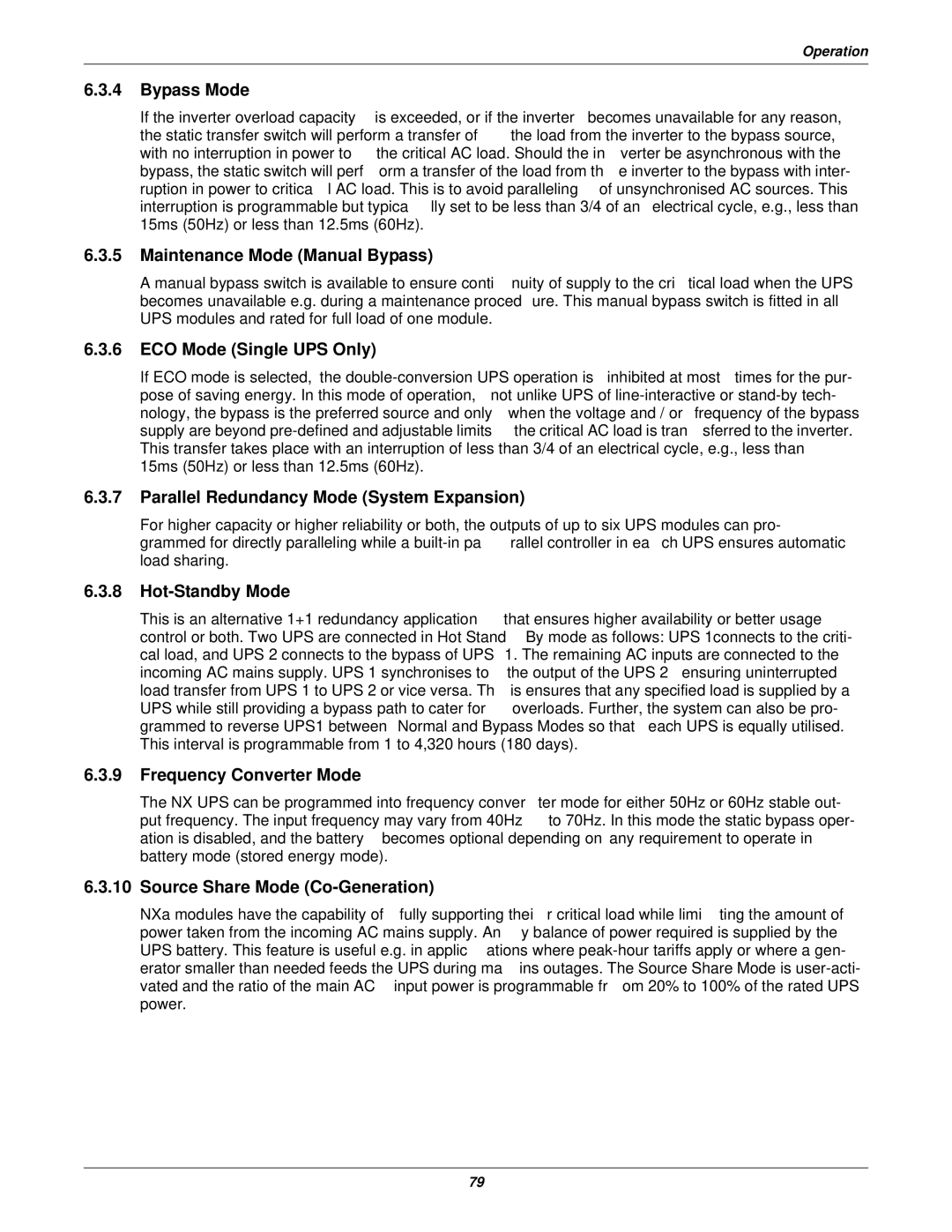Liebert NX
Page
Table of Contents
External Optional Cabinets
UPS MULTI-MODULEINSTALLATION
Operator Control Panel and Display
Operating Procedures
Technical Specifications
OPTIONS-FORASSEMBLY Inside the UPS Cabinet
Figures
Page
Tables
Emerson Network Power
Options Model Identification
Feature Set For Region Input
Output
Aust/NZ
Page
Conformity and Standards
For more details, see 10.0 Technical Specifications
Back-Feed Protection Notice
Battery Voltage Exceeds 400VDC
User-Serviceable Parts
Preliminary Checks
Professional Installation Required
Battery Hazards
Introduction
Storage
External Battery Room
Location
UPS Room
3 60-200kVA UPS
Positioning
System Cabinets
2 30 to 40kVA UPS
External Protective Devices
UPS Output
External Battery
Rectifier and Bypass Input
Earth Leakage RCD
Maximum steady state AC and DC currents
Power Cables
Distance from floor to connection point on the equipment
Split-Bypass Connections
Frequency Converter Mode
Cable Termination
Common Input Connections
Hazardous Battery Terminal Voltage 480VDC
Internal UPS Battery Connection 30/40kVA only
Output System Connections
Control Cables and Communication
Monitor Board Features
Input dry contacts at
X3 Ancillary Control and Alarms
Dry Contacts
Input Dry Contacts
Maintenance bypass cabinet interface
Maintenance Bypass Cabinet Interface
External Circuit-Breaker Interface
J13 J21 J25
Emergency Power Off Input
Output Dry Contacts
Output dry contact relays for firmware before M162
EPO input contact relays
X5 Auxiliary DC Power Output
X7 External Battery Temperature Detector Interface
X6 Analog Input Interface
Serial Ports RS232-1 and RS232-2
External Bypass Switch Interlock
Battery Installation
Introduction
Safety
Battery Cabinet
Hazardous battery voltage present behind covers
Circuit Breaker Features
Temperature Considerations
Dimensions
Weight
Moving the Battery Cabinets
Front View
Top
Narrow battery cabinet with top cable entry location
Side View
Bottom View Front View
BCB
Large battery cabinet dimensions
BCB
SENXA0NBCN4LCB.eps
SENXA0NBCN4LF
SENXA0NBCN5LCB
SENXA0NBCN5LF
SENXA0NBCWXX3LCB
SENXA0NBCWXX3LF
SENXA0NBCWXX4LCB2x4
SENXA0NBCWXX4LCB4x2
Tray master Layer
SENXA0NBCWXX4LF2x4
SENXA0NBCWXX4LF4x2
Connection Principles
Battery Power Cables
Connecting the Battery
Battery Room Design
For details, refer to 1.7 Control Cables and Communication
Battery Control
HxWxD, mm Kg lb Circuit Breaker
Battery Circuit Breaker Box
UPS-circuit breaker configurations
Dimensions Weight
Circuit Breaker Box 140-200kVA
Battery circuit breaker box legend
Key # Component
Battery circuit breaker box connection
Name W2 L = 30m
Battery Temperature Sensor-Optional
Battery control label description
Cable W2 is packed with the temperature sensor
Type W3 L = 5m Type W3 L = 30m
X21
General
X23 X24 Monitor Board
X24
Paralleled UPS Modules
Cabinet Installation
Inverter
QByp
Power Cables
External Protective Devices
Q1Ext Q2Ext QnExt
Control Cables Intermodule Control
Hot-Standby UPS Modules
L1, L2, L3, N
Mains L1, L2, L3, N
Mains L1 Bypass L1
Rectifier
Dual Bus System
Parallel Board DBS Cable X2-2 X1-1 Parallel System
Control Wires
Extended Dual Bus Synchronization Option DBS Interface Box
Parallel Board X2-2 X1-1 Parallel System
Interlock with UPS Module
External Maintenance Bypass Cabinets
Cabinet
Isolation Transformer Option
Dual input external isolation transformer cabinet
Top Cable Entry Option
UPS
General arrangement-30-40kVA UPS
Front view, door open30-40kVA NX
348 323 299 258
Location of parallel logic board M3 and options-30-40kVA NX
Blue
General arrangement-60-80kVA NX
Front view doors open-60-80kVA NX
Batt +
Cable terminal layout-60-80kVA NX
Front view Side view
Front view, door open-100-120kVA NX
General arrangement-140-200kVA NX
Cable terminal layout-100-120kVA NX
Parallel Cable
Cable terminal layout-140-200kVA NX
Optional external Maintenance Bypass Cabinet, 600mm wide
Top View
Optional External Maintenance Bypass Cabinet, 850mm wide
Cabling diagram, 30-200kVA, MBP-T cabinet, configuration
Cabling diagram, 30-200kVA, MBP-T cabinet, configuration
Cabling diagram, 30-200kVA, MBP-T cabinet, configuration
Isolator Input Static Switch
DC Bus Inverter Static Switch Rectifier Input Mains Supply
Battery Output Isolator
Output Converter Battery CB Circuit Breaker
Redundant Control Power Supply Board
Static Transfer Switch
Battery Circuit Breaker
Battery Temperature Compensation
Multi Module UPS-1+N
Features of NX Multi-Module UPS Configurations
Distribution Cabinet
Modes of Operation
Normal Mode
Battery Mode Stored Energy Mode
Auto-Restart Mode
Parallel Redundancy Mode System Expansion
Bypass Mode
Maintenance Mode Manual Bypass
ECO Mode Single UPS Only
Battery Protection settings by commissioning engineer
Battery Management-Set During Commissioning
Normal Function
Operating Procedures
Startup in Normal Mode
LED Function Status
# LED
Battery Test Mode Procedures
Startup into ECO Mode
Test Procedure
Risk of Load Interruption
Maintenance Bypass Procedure and UPS Shutdown
UPS Self-Test Procedure
UPS Self-Test
Do not press any remote EPO button
External Maintenance Bypass Cabinet
Multi-Module Systems With External Output CB1
Isolation of One Module in a Multi-Module System
Multi-Module System Without External Output Circuit Breaker
Hazardous Battery Voltage
Insertion of One Module in a Multi-Module System
Emergency Shutdown With EPO
Shutdown Procedure-Complete UPS and Load Shutdown
Auto Restart
Language Selection
Command Password
Changing the Current Date and Time
Component # Function
UPS control and display panel components
Button Function
Audible Alarm Buzzer
Mimic Power Flow
LCD Monitor and Menu keys
Direct Access Push Buttons Keys
Menu key Icons and their meaning
Displayed on the front LCD. When not activated,
Load System Battery Records
Language Settings Command Version
When configured, input transformer voltages are
Descriptions of UPS menus and data window items
Detailed Description of Menu Items
UPS system window
Menu and Data Window
Freshening Charge
UPS messages
Current Record Window
Message Description / Suggested Action if any
Frequency of bypass voltage is beyond the normal range
100
101
102
Prompt windows, meanings
Prompt Pop-Up Windows
Prompt Meaning
Default Screen Saver
Dynamic Energy Flow Chart and UPS Help Screen
Seismic Anchors
Battery Start Facility
Protection
Redundant Back-Feed Protection
WxLxH, mm Value uH
Bypass current sharing inductors-dimensions, values
Dimensions Inductor
Bypass Current Sharing Inductors
Bypass Current
Input Output
Sharing Induct
Contactor
Battery Ground Fault Detection
Terminal Name Definition
Replacing Dust Filters
Redundant Fan for Power Module
Communication bays and cable location
Communication and Monitoring
OC Web Card data summary window
OC Web Card SNMP/HTTP Network Interface Card
Connection Description
Relay Card pin configuration
Relay Card
Pin Function Operation
Pin Description
Multiport-4 Card
SiteNet MultiPort4 Intellislot pin assignment
Assignment
4 OC485 Web Card Modbus, Jbus, IGM Net
Remote Alarm Monitor
Comments
Conformity and Standards
Environmental characteristics
Compliance with European, international standards
Rectifier AC input mains
Mechanical characteristics
Intermediate DC circuit, battery
Inverter output to critical load
Bypass input
That
Net
Iti
Tin

